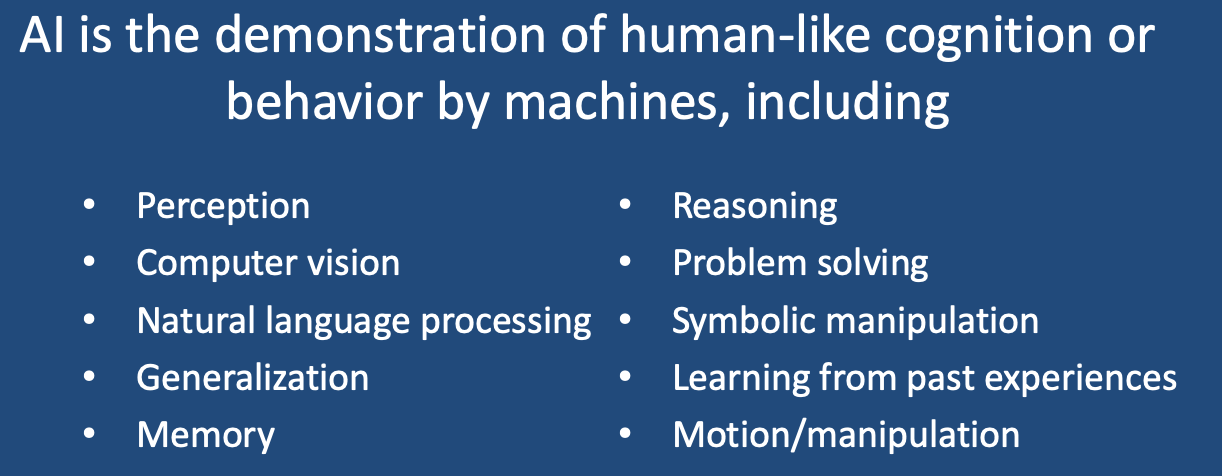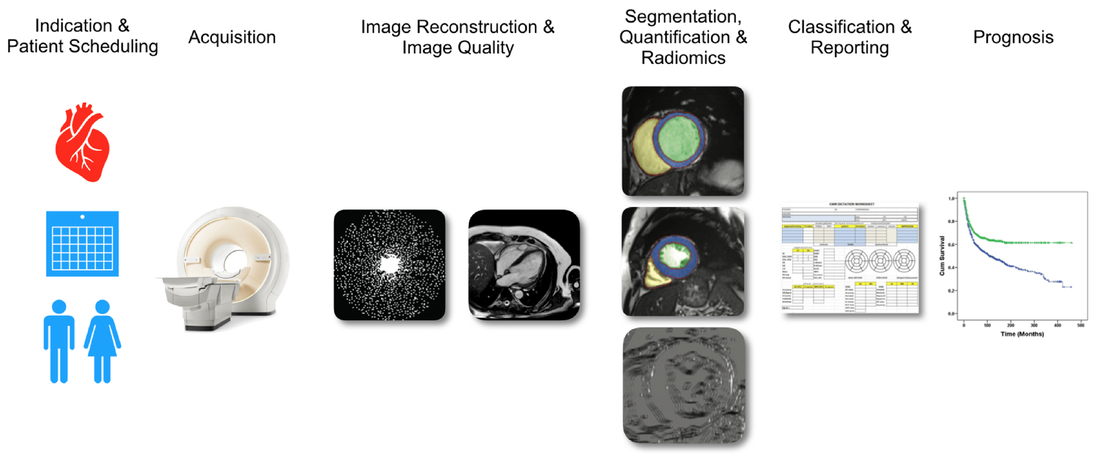Artificial intelligence (AI) is the process by which computers and other machines demonstrate human-like cognition or behavior. The term was first coined in the 1950s, but has only been widely popularized over the last 15 years.
"Human-like" intellectual processes potentially mimicked by computing machines include:
- Symbolic manipulation
- “Perception” and computer “vision” – the extraction of information from sensors (such as cameras, microphones, MRI scanners, and other electronic devices), processing the data to recognize patterns, identify objects, and relationships between them.
- Natural language processing – the ability to read and understand human language
- Reasoning and problem-solving
- Learning from past experiences, generalization
- Motion and manipulation (primarily used in robotics)

The simplest (and oldest) forms of AI are rules-based computer algorithms that produce rapid calculations, data queries, and answers to common questions. These methods are referred to as symbolic AI, expert systems, knowledge graphs, or "good old-fashioned AI". The intelligence that such systems can mimic can be impressive, such as an accountant's knowledge of the US Tax Code (TurboTax) or a mathematician's ability to prove theorems or simplify complex equations (Mathematica). Less remarkable examples include early chatbots (e.g., the much-maligned Microsoft "Clippy"), video gaming systems, and finalized commercial software products for optical character recognition, acid-base analysis, decision-making, and scheduling.
More advanced forms of AI are based on neural networks, architectures that are loosely modeled after the human nervous system. Neural networks include both general machine learning (ML) and its more complex subset deep learning (DL). The operational word here is "learning", as advanced neural networks actually modify their internal parameters and improve their performance automatically over time through experience and the use of data. Advanced AI is already present in our everyday lives: when we use Google search engines, receive a Facebook ad, get a Netflix recommendation, or talk to Siri. Current and potential applications for AI in medicine and medical imaging include:
More advanced forms of AI are based on neural networks, architectures that are loosely modeled after the human nervous system. Neural networks include both general machine learning (ML) and its more complex subset deep learning (DL). The operational word here is "learning", as advanced neural networks actually modify their internal parameters and improve their performance automatically over time through experience and the use of data. Advanced AI is already present in our everyday lives: when we use Google search engines, receive a Facebook ad, get a Netflix recommendation, or talk to Siri. Current and potential applications for AI in medicine and medical imaging include:
|
|
Advanced Discussion (show/hide)»
The concept of what "intelligence" actually means has deep philosophical roots. The interested reader should check out the chapter on Artificial Intelligence in the on-line Stanford Encyclopedia of Philosophy referenced below.
References
Bringsjord S, Govindarajulu NS. Artificial Intelligence. In: Zalta EN (ed.), The Stanford Encyclopedia of Philosophy, 2020. (Downloaded from https://plato.stanford.edu/entries/artificial-intelligence/ 17 Jan 2022.)
European Society of Radiology. What the radiologist should know about artificial intelligence - an ESR white paper. Insights into Imaging 2019;1:44.
Kocak B, Kus EA, Kilickesmez O. How to read and review papers on machine learning and artificial intelligence in radiology: a survival guide to key methodological concepts. Eur Radiology 2021; 31:1819-1830. [DOI LINK]
Leiner T, Rueckert D, Suinesiaputra A, et al. Machine learning in cardiovascular magnetic resonance: basic concepts and applications. J Cardiovasc Magn Reson 2019; 21:61 [DOI LINK]
McCarthy J, Minsky ML, Rochester N, Shannon, CE. Proposal for the Dartmouth summer research project on artificial intelligence. Technical Report, Dartmouth College, 1955. (First use of the term AI).
Bringsjord S, Govindarajulu NS. Artificial Intelligence. In: Zalta EN (ed.), The Stanford Encyclopedia of Philosophy, 2020. (Downloaded from https://plato.stanford.edu/entries/artificial-intelligence/ 17 Jan 2022.)
European Society of Radiology. What the radiologist should know about artificial intelligence - an ESR white paper. Insights into Imaging 2019;1:44.
Kocak B, Kus EA, Kilickesmez O. How to read and review papers on machine learning and artificial intelligence in radiology: a survival guide to key methodological concepts. Eur Radiology 2021; 31:1819-1830. [DOI LINK]
Leiner T, Rueckert D, Suinesiaputra A, et al. Machine learning in cardiovascular magnetic resonance: basic concepts and applications. J Cardiovasc Magn Reson 2019; 21:61 [DOI LINK]
McCarthy J, Minsky ML, Rochester N, Shannon, CE. Proposal for the Dartmouth summer research project on artificial intelligence. Technical Report, Dartmouth College, 1955. (First use of the term AI).
Related Questions
What is an artificial neural network?
Is deep learning (DL) the same as machine learning (ML)?
What is an artificial neural network?
Is deep learning (DL) the same as machine learning (ML)?

